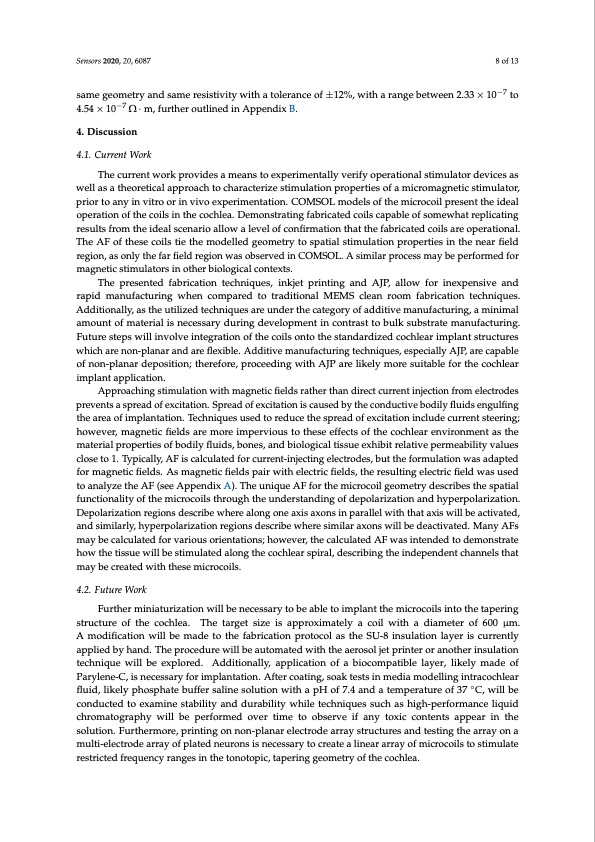
PDF Publication Title:
Text from PDF Page: 008
Sensors 2020, 20, 6087 8 of 13 same geometry and same resistivity with a tolerance of ±12%, with a range between 2.33 × 10−7 to 4.54 × 10−7 Ω · m, further outlined in Appendix B. 4. Discussion 4.1. Current Work The current work provides a means to experimentally verify operational stimulator devices as well as a theoretical approach to characterize stimulation properties of a micromagnetic stimulator, prior to any in vitro or in vivo experimentation. COMSOL models of the microcoil present the ideal operation of the coils in the cochlea. Demonstrating fabricated coils capable of somewhat replicating results from the ideal scenario allow a level of confirmation that the fabricated coils are operational. The AF of these coils tie the modelled geometry to spatial stimulation properties in the near field region, as only the far field region was observed in COMSOL. A similar process may be performed for magnetic stimulators in other biological contexts. The presented fabrication techniques, inkjet printing and AJP, allow for inexpensive and rapid manufacturing when compared to traditional MEMS clean room fabrication techniques. Additionally, as the utilized techniques are under the category of additive manufacturing, a minimal amount of material is necessary during development in contrast to bulk substrate manufacturing. Future steps will involve integration of the coils onto the standardized cochlear implant structures which are non-planar and are flexible. Additive manufacturing techniques, especially AJP, are capable of non-planar deposition; therefore, proceeding with AJP are likely more suitable for the cochlear implant application. Approaching stimulation with magnetic fields rather than direct current injection from electrodes prevents a spread of excitation. Spread of excitation is caused by the conductive bodily fluids engulfing the area of implantation. Techniques used to reduce the spread of excitation include current steering; however, magnetic fields are more impervious to these effects of the cochlear environment as the material properties of bodily fluids, bones, and biological tissue exhibit relative permeability values close to 1. Typically, AF is calculated for current-injecting electrodes, but the formulation was adapted for magnetic fields. As magnetic fields pair with electric fields, the resulting electric field was used to analyze the AF (see Appendix A). The unique AF for the microcoil geometry describes the spatial functionality of the microcoils through the understanding of depolarization and hyperpolarization. Depolarization regions describe where along one axis axons in parallel with that axis will be activated, and similarly, hyperpolarization regions describe where similar axons will be deactivated. Many AFs may be calculated for various orientations; however, the calculated AF was intended to demonstrate how the tissue will be stimulated along the cochlear spiral, describing the independent channels that may be created with these microcoils. 4.2. Future Work Further miniaturization will be necessary to be able to implant the microcoils into the tapering structure of the cochlea. The target size is approximately a coil with a diameter of 600 μm. A modification will be made to the fabrication protocol as the SU-8 insulation layer is currently applied by hand. The procedure will be automated with the aerosol jet printer or another insulation technique will be explored. Additionally, application of a biocompatible layer, likely made of Parylene-C, is necessary for implantation. After coating, soak tests in media modelling intracochlear fluid, likely phosphate buffer saline solution with a pH of 7.4 and a temperature of 37 ◦C, will be conducted to examine stability and durability while techniques such as high-performance liquid chromatography will be performed over time to observe if any toxic contents appear in the solution. Furthermore, printing on non-planar electrode array structures and testing the array on a multi-electrode array of plated neurons is necessary to create a linear array of microcoils to stimulate restricted frequency ranges in the tonotopic, tapering geometry of the cochlea.PDF Image | Silver-Nanoparticle Microcoil via Aerosol Jet Printing

PDF Search Title:
Silver-Nanoparticle Microcoil via Aerosol Jet PrintingOriginal File Name Searched:
sensors-20-06087-v2.pdfDIY PDF Search: Google It | Yahoo | Bing
Turbine and System Plans CAD CAM: Special for this month, any plans are $10,000 for complete Cad/Cam blueprints. License is for one build. Try before you buy a production license. More Info
Waste Heat Power Technology: Organic Rankine Cycle uses waste heat to make electricity, shaft horsepower and cooling. More Info
All Turbine and System Products: Infinity Turbine ORD systems, turbine generator sets, build plans and more to use your waste heat from 30C to 100C. More Info
CO2 Phase Change Demonstrator: CO2 goes supercritical at 30 C. This is a experimental platform which you can use to demonstrate phase change with low heat. Includes integration area for small CO2 turbine, static generator, and more. This can also be used for a GTL Gas to Liquids experimental platform. More Info
Introducing the Infinity Turbine Products Infinity Turbine develops and builds systems for making power from waste heat. It also is working on innovative strategies for storing, making, and deploying energy. More Info
Need Strategy? Use our Consulting and analyst services Infinity Turbine LLC is pleased to announce its consulting and analyst services. We have worked in the renewable energy industry as a researcher, developing sales and markets, along with may inventions and innovations. More Info
Made in USA with Global Energy Millennial Web Engine These pages were made with the Global Energy Web PDF Engine using Filemaker (Claris) software.
Infinity Turbine Developing Spinning Disc Reactor SDR or Spinning Disc Reactors reduce processing time for liquid production of Silver Nanoparticles.
| CONTACT TEL: 608-238-6001 Email: greg@infinityturbine.com | RSS | AMP |